The team spent the past three months travelling from Casablanca to the Cape, passing through Morocco, Mauritania, Senegal, Mali, Niger, Nigeria, Cameroon, Gabon, the Congo, the DRC, Angola and Namibia to arrive in Table Bay.
They used a Land Cruiser pick-up, as well as two Land Cruiser 70 wagons, and according to Badenhorst the Cruisers were the ideal vehicles for the trip. “This journey – the sixth in the past nine years – was by far the most challenging,” he added.
The team travelled from the snow capped Atlas mountains through the Sahara where temperatures soared into the high 40s, intermittent rain in the Tropics, numerous African border controls and road blocks, all the way down south in an effort to complete the 23 000km journey in less than 100 days.
During this time the vehicles were subjected to the most extreme conditions imaginable on rutted, corrugated and sometimes non-existent roads. On average the team has to complete 230 km per day for 100 days to achieve its target, but some days the convoy managed less than 100 km.
This meant even more pressure on the vehicles catching up the next day, but according to Badenhorst the Cruisers were up to any challenge. “It is in these circumstances that you need the most reliable vehicles, and that was exactly what we had with our three Cruisers.”
The diesel pick-up, driven by Gary Swemmer, had the toughest task carrying most of the luggage. With its heavy load it sometimes struggled in the soft Sahara sand “but it was a small price to pay compared to its invaluable contribution as a reliable workhorse,” said Badenhorst.
Johan and Francois Marais were behind the controls of the two Cruiser 70 wagons. They found them really comfortable vehicles to be in when conquering Africa, as their shorter wheelbase assisted in tackling any kind of terrain with ease.
“Differential locks front and rear, as well as their reliable 4.2 litre diesel engines, convinced the team that there is no other vehicle as apt for the job as the Cruisers,” said Badenhorst.
A highlight of the adventure was a visit to the wreck of the Pelican 16, a South African Shackleton plane that crash-landed in the Western Sahara in 1994. Today this area is a disputed area, fought over by the Moroccan army and the Polisario Front.
The team also visited historical sites like Gorée Island in Dakar, the cliffs of Bandiagara, Timbuktu on the edge of the Sahara with its new South African-sponsored library, the Muslim north of Nigeria, the rain forest of Cameroon, the Namib coastline of Angola, Damaraland in Namibia and the floral kingdom of Namaqualand in South Africa.
Obstacles were aplenty, such as the team being arrested in Agadez in Niger for four days, as well as having to wait for four days to be allowed into Angola at Matadi on the border of the DRC.
The team originally consisted of six members – Johan Badenhorst as leader, cameraman Lourens Human, photographer Stefan Sonnekus, mechanic Gary Swemmer, field guide Nobert Coetzee and logistics manager Francois Marais. In Cameroon the team was joined by Johan’s 13-year old son, Streicher.
Close to the end of the very tough expedition the team was welcomed by 60 enthusiastic well wishers at Sendelingsdrift, on the border between South Africa and Namibia.
The whole group, in a convoy of 30 vehicles, travelled with the team via Hondeklipbaai and Lamberts Bay all the way down to Bloubergstrand, the journey’s final destination.
Voetspore, Van Casablanca tot die Kaap, is an adventure documentary television series, to be broadcast later this year on SABC2. For more information, visit www.voetspore.co.za









